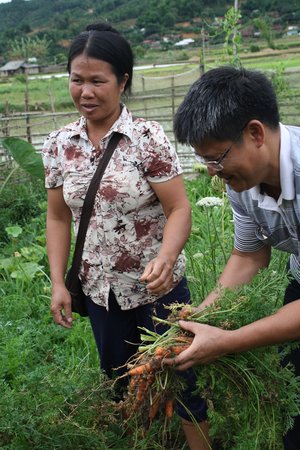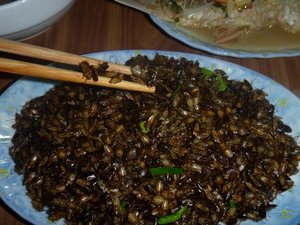Putting nutrition data to work in the community

Jessica Raneri sends her fourth blog from Vietnam, where we are working with local communities to improve nutrition through dietary diversity.
In the fourth of her blog reports from Vietnam, Jessica Raneri, Nutrition Programme Specialist, explains some of the emerging findings from research in the Mai Son district in Son La Province, to assess local food biodiversity and identify opportunities for improving diet quality and diversity.
By Jessica Raneri
In my last blog, I reported on collecting baseline data from 400 households in four rural and farming communes of Mai Son district in Son La Province. This stage was to identify the current availability, access and use of agricultural biodiversity, nutrition knowledge and practices, both on and off the farm. We collected data in both the rainy pre-harvest season and the dry post-harvest season, to capture differences in seasonal food availability and consumption at these times.
Data collection during the rainy season presented many challenges as torrential rains meant that many of the access roads were blocked, but with some determination and the help of a buffalo, we managed to overcome them.
Now we have analyzed this data to inform the exciting next step – when we work closely with the communities and local health and agricultural partners to design appropriate interventions to improve nutrition in the project sites. We call this the Participatory Identification of Intervention Approach, or PIIA for short.
 Our analysis has shown that when looking at the availability of species at the landscape level – including those that are produced and available in the wild – the number of species that represent high nutrition food groups such as dark green leafy vegetables, legumes, meat and some fruits is quite low. Further analysis on what is actually consumed in the household, which also takes into account foods purchased at the markets, shows that these high nutrition food groups are also not being consumed in sufficient amounts. It also shows that over 80% of foods consumed are from a household’s own production. While we hope to increase the overall production of species richness available at the landscape level, this baseline data has given us the primary goal to increase the species richness of nutritious foods at the household level and combine this with nutrition education, to increase their consumption.
Our analysis has shown that when looking at the availability of species at the landscape level – including those that are produced and available in the wild – the number of species that represent high nutrition food groups such as dark green leafy vegetables, legumes, meat and some fruits is quite low. Further analysis on what is actually consumed in the household, which also takes into account foods purchased at the markets, shows that these high nutrition food groups are also not being consumed in sufficient amounts. It also shows that over 80% of foods consumed are from a household’s own production. While we hope to increase the overall production of species richness available at the landscape level, this baseline data has given us the primary goal to increase the species richness of nutritious foods at the household level and combine this with nutrition education, to increase their consumption.
The next step was to return to the villages to share our data with them, and I am glad to report that even though it was rainy season, and the weather hot and humid, the roads remained open.
The first day started off with light-hearted icebreakers such as asking the farmers to tell us their favourite foods. We then explained the results of the baseline, communicating through simple pictures and diagrams, that 1 in 3 children were stunted, more than 42% of women and children had poor dietary diversity, specifically in regards to a lack of foods consumed from Vitamin-A rich fruits and vegetables, dark green leafy vegetables and legume food groups. We discussed why these food groups are important for health and nutrition and explored the concept of dietary diversity. We ended the session with the group developing a statement that nutrition is important and a commitment that they will find ways to produce and consume more of these nutritious foods.
We then broke into three groups, each focusing on a particular nutritious food group such as dark green leafy vegetables, to discuss and prioritize together which 1-4 species/varieties from these food groups were the preferred ones to eat and grow. It was fantastic to see the dynamic conversations and negotiations that followed, as the final choices were made.
These foods will be the foundation of our integrated agriculture nutrition intervention. The agricultural side will focus on strengthening the capacity of the participants to grow these foods, as well as seed saving and post-harvest storage. The nutrition side will focus on education about why these foods are important to eat and experimenting with innovative ways to cook, prepare and preserve them to increase their appeal and ultimately consumption.
On the second day we focused on developing the impact pathways to ensure greater consumption of these foods – through identification of the barriers and ways to overcome them at each step from planting material in the ground, to growing, harvesting and consumption. This included groups deciding they would form village level 'Diversity Clubs', and how frequently they would meet, what barriers they would address (e.g. new recipes) and how they would be supported (e.g. each member would bring supplies for the cooking classes).
 Sharing lunch with the farmers at the end of a busy morning is always satisfying. The tables are always a prime example of how the diversification of the diet can be both appealing to the taste buds as well as to the eyes. There is always something new to try, and sometimes pushing our own limits to our standard dietary practices. But lead by example I say! How can we expect the people and their communities we work with to branch out and try new foods, if we ourselves cannot do the same? So down the hatch went the following: fried stink bugs, boiled hornet larvae with ginger, fried tiny wild birds, wild sour shrub leaves, fermented soy and chilli paste mixed with pungent fresh water shrimp, and grated banana flower salad with peanuts.
Sharing lunch with the farmers at the end of a busy morning is always satisfying. The tables are always a prime example of how the diversification of the diet can be both appealing to the taste buds as well as to the eyes. There is always something new to try, and sometimes pushing our own limits to our standard dietary practices. But lead by example I say! How can we expect the people and their communities we work with to branch out and try new foods, if we ourselves cannot do the same? So down the hatch went the following: fried stink bugs, boiled hornet larvae with ginger, fried tiny wild birds, wild sour shrub leaves, fermented soy and chilli paste mixed with pungent fresh water shrimp, and grated banana flower salad with peanuts.
We also took time to visits the farms, where we realized that farmers are currently selecting which species to grow based on a variety of agronomic and input availability, for example, the cost of seed, tradition or seeing what others do. There seems to be no active planning taking place to ensure that a diverse variety of nutritious foods would be available from the homegarden throughout the year. We then took the design of the proposed interventions to the North West Vietnam Research for Development Platform for consultation and further refinement. The platform – a multiple stakeholder platform that allows for higher level input to guide interventions – supported the interventions, which will start at the end of this year.
For more information, please contact:
Jessica Raneri
Read Jessica’s other blogs about this research:
Part 1 : Assessing the nutrition potential of diverse local foods in Vietnam
Part 2 : Bringing together best methods to assess food quality and dietary intake in Vietnam
Part 3 : Improving dietary quality and diversity through systems innovation
Part 6: Spicing it up to increase vitamin A consumption in Vietnam
This is part of research under the CGIAR Research Programs on Humidtropics and Agriculture for Nutrition and Health, and contributes to Bioversity International's Healthy Diets from Sustainable Food Systems Initiative. The focus of this research is on women of child-bearing age and children between 12-23 months – an age group part of the critical 1000 day window for child development and the stage where they are able to consume a more diverse diet. As such, it is from this age group that biodiversity can have an effect on the diet.
Photos:
(Top) Sharing baseline nutrition data and plan interventions with the community.
(Middle) Baseline results show that over 80% of foods consumed in the home, come from home production.
(Bottom) A local dish of fried stinkbugs
Credit all photos: Bioversity International/J. Raneri
